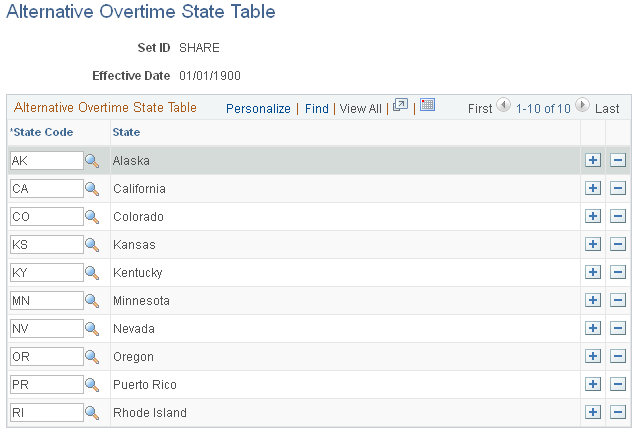Setting Up for Alternative Overtime Calculation
Note: The federal version of Payroll for North America does not use the alternative overtime functionality.
|
Page Name |
Definition Name |
Usage |
|---|---|---|
|
ALT_OT_STATES |
Identify the states that have alternative overtime requirements. |
|
|
Job Information Page |
JOB_DATA_JOBCODE |
Enter information about a person's job, including status, employee class, standard hours, and FLSA status. Identify employees who are subject to alternative overtime calculations by selecting ALT OT in the FLSA Status field. |
Some states require different overtime calculations than those managed by the Federal Fair Labor Standards Act (FLSA) regulations. For example, the FLSA overtime premium calculation is fixed at 0.5, whereas California requires that daily overtime in excess of 12 hours must be paid at double time.
This feature is useful for any organization that pays employees in California or other applicable states or requires the alternate calculation because of union or company agreements.
Setup Steps
Alternative overtime calculation applies only to FLSA-eligible employees. All normal FLSA setup must be done to support alternative overtime calculation processing.
In addition to the normal FLSA setup, these additional setup steps are required for alternative overtime processing:
Set up the Alternative Overtime State table to identify the states in which alternative overtime calculations should apply.
PeopleSoft delivers sample data for the SHARE setID showing states that have alternative overtime requirements. You can use this information when you set up the table for your setIDs and add additional states as necessary according to your alternative overtime business rules.
Identify employees who are subject to Alternative Overtime calculations.
Select ALT OT in the FLSA Status field on the Job Information page in the employee's job data.
Note: California employees who work less than 40 hours get overtime pay on an FLSA basis if their FLSA Status is either Nonexempt or Alt OT. The difference between the two statuses is that Nonexempt causes a fixed multiplier of 0.5 to be applied, whereas Alt OT uses the earnings code's multiplier. If the earnings code's multiplier is also 0.5, then the overtime amounts are the same for the two statuses.
Processing Description
Salaried employees with unspecified hours are always calculated with the alternative rate, even if it is lower than the contractual rate. The alternative overtime calculation applies even if an employee works less than 40 hours in a week.
Note: Payroll for North America does not provide functionality to analyze daily hours and split them between normal time and one or more overtime rates. You must input this information using PeopleSoft Time and Labor or another method.
The system follows these steps in processing alternative overtime:
To see if the employee is eligible for alternative overtime calculations, the system first looks to the FLSA status on the employee's job information.
If the employee is eligible, the system then confirms that the state defined on the payline is on the Alternative Overtime States record.
For those employees identified, the system calculates overtime on the alternative basis rather than the usual FLSA method.
To calculate alternative overtime, the system uses the multiplication factor specified for the overtime earnings code on the Earnings table instead of the fixed 0.5 used in federal FLSA calculation.
When the overtime has been calculated by the alternative method, the system displays the rate with the label Alternative Rate rather than FLSA Rate.
Use the Alternative Overtime State Table page (ALT_OT_STATES) to identify the states that have alternative overtime requirements.
Navigation
Image: Alternative Overtime State Table page
This example illustrates the fields and controls on the Alternative Overtime State Table page.

The SHARE set ID is delivered as sample data showing the states that have alternative overtime requirements. Set up the table for your organization's setIDs according to your company's alternative overtime business rules.
|
Field or Control |
Definition |
|---|---|
| State Code |
Enter the 2-character state code to identify in which state alternative overtime calculations should apply. |